
What Processes Affect Ocean Temperature and Salinity in Tropical and Polar Regions?
THE EXTREMES IN SEAWATER TEMPERATURE AND SALINITY occur at high and low latitudes. The warmest and most saline waters occur in the tropics and subtropics, while very cold, less saline waters occur near the poles, away from where ice is actively forming. Here, we examine the processes occurring in some of the warmest and coldest […]
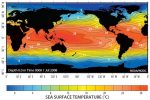
What Are the Global Patterns of Temperature and Salinity?
THE OCEANS VARY IN SALINITY from place to place and with depth. Spatial variations are due to differences in the amount of evaporation and formation of ice, which increase salinity, versus the amount of precipitation, input from streams, and melting of ice, all of which add fresh water that dilutes the salinity. Also, saline waters […]
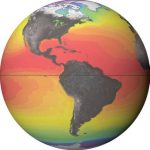
How Do Sea-Surface Temperatures Vary from Place to Place and Season to Season?
SEA-SURFACE TEMPERATURES (SST) VARY GREATLY, from bathwater warm to slightly below freezing. Early data on SST were collected from ships, but since the 1970s, satellites have collected voluminous SST data, documenting variations in temperature from region to region, season to season, and decade to decade. SST data have become even more important as climatologists investigate […]

How Do Variations in Temperature and Pressure Cause Local Atmospheric Circulation?
PRESSURE GRADIENTS INDUCE FLOW at all scales, including local and regional ones, arising from unequal heating by insolation and latent heat, by differing thermal responses of land versus sea, and even from the construction of large metropolitan areas. Such circulations contribute to the climate of a place, particularly in the absence of, or interaction with, […]

How Do Gases Respond to Changes in Temperature and Pressure?
THE ATMOSPHERE CONSISTS LARGELY OF GASES, with lesser amounts of liquids, such as drops of water, and solids, such as dust and ice. By nature, gases expand easily or contract in volume in response to changes in temperature and pressure. Variations in temperature and resulting changes in pressure are the main drivers of motion in […]
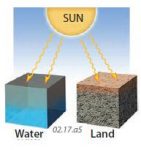
Why Do Temperatures Vary Between Oceans and Continents?
WATER EXHIBITS VERY DIFFERENT thermal properties from those displayed by the rocks and soil of land. These differences in thermal properties cause oceans and land to warm and cool at different rates, leading to significant temperature variations between oceans and land. Such differences help explain major patterns of global temperature and climate. How Do Water […]
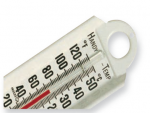
What Are Heat and Temperature?
THE TERMS HEAT AND TEMPERATURE are used every day, but what do they actually mean? Temperature is a measure of the object's internal kinetic energy — the energy contained within molecules that are moving, and heat is thermal energy transferred from one object to another. Moving molecules drive many processes in the Earthocean-atmosphere system, such […]
Crickets and other temperature scales
Even after the thermometer was invented, it wasn't obvious how to set its readings. Scientists bickered over which points on the scale should be tied to something in the natural world. Some favoured 'blood heat” or body temperature. In northern Europe, where thermometers were refined in the eighteenth century, people didn't expect air temperature to […]
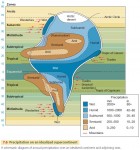
Temperature and Precipitation Regimes
Many parts of the world show distinctive patterns of monthly temperature and precipitation, usually related to latitude and location. These patterns are referred to as regimes of temperature and precipitation. TEMPERATURE REGIMES Figure 7.5 shows annual cycles of air temperature for different temperature regimes. The equatorial regime (Douala, Cameroon, 4° N) is uniformly very warm, with temperatures close to 27°C (81°F) […]
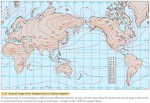
World Patterns of Air Temperature
We have learned some important principles about air temperatures in this chapter. Surface type (urban or rural), elevation, latitude, daily and annual insolation cycles, and location (maritime or continental) can all influence air temperatures. Now let's put all these together and see how they affect world air temperature patterns. First, we need a quick explanation of air temperature maps. Figure 3.21 shows a set of isotherms—lines connecting locations […]
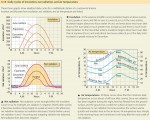
Daily and Annual Cycles of Air Temperature
Let's turn to how, and why, air temperatures vary around the world. Insolation from the Sun varies across the globe, depending on latitude and season. Net radiation at a given place is positive during the day, as the surface gains heat from the Sun's rays. At night, the flow of incoming shortwave radiation stops, but the Earth continues to radiate longwave […]
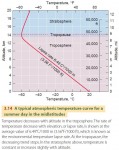
Temperature Structure of the Atmosphere
In general, the air is cooler at higher altitudes. Remember from Chapter 2 that most incoming solar radiation passes through the atmosphere and is absorbed by the Earth's surface. The atmosphere is then warmed at the surface by latent and sensible heat flows. So it makes sense that, in general, air farther from the Earth's surface will be cooler. We call […]

Surface and Air Temperature
This chapter focuses on air temperature—that is, the temperature of the air as observed at 1.2 m (4 ft) above the ground surface. Air temperature conditions many aspects of human life, from the clothing we wear to the fuel costs we pay. Air temperature and air temperature cycles also act to select the plants and animals that make up the biological landscape of a region. […]